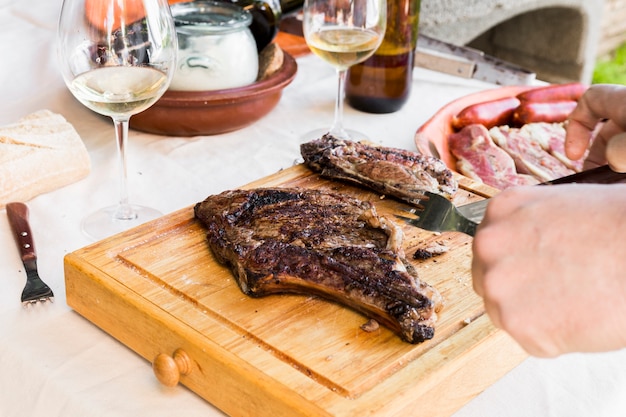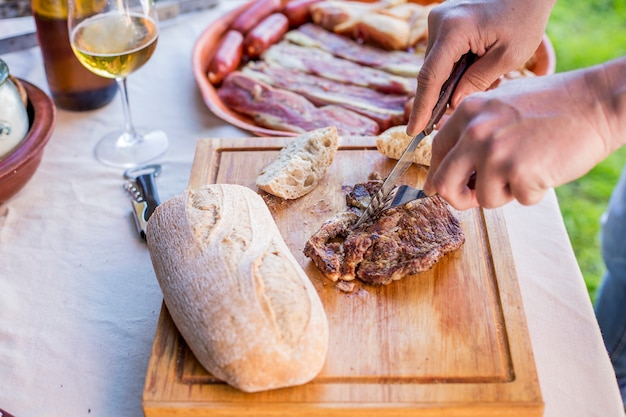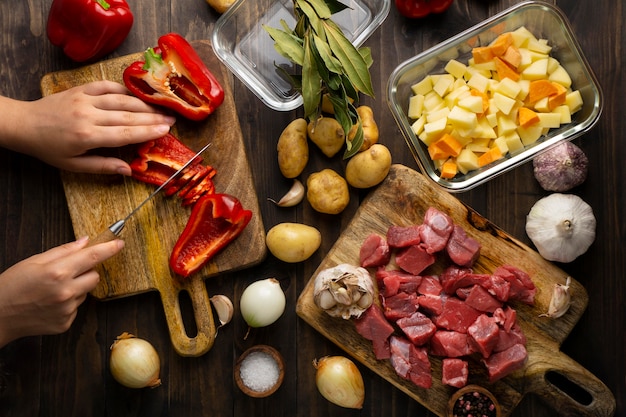Let's talk about a true culinary triumph: cooking the perfect ribeye steak on the grill. As a seasoned grill master (and a self-proclaimed carnivore enthusiast), I've dedicated years to mastering the art of transforming a humble ribeye into a mouthwatering masterpiece. Now, I'm ready to share my secrets with you! So, grab your tongs, fire up your grill, and get ready to embark on a culinary adventure that'll leave you savoring every juicy, smoky bite.
(Part 1) Choosing the Star of the Show: Your Ribeye Steak
Picking the Perfect Cut

You can't have a perfect ribeye without the perfect ribeye to begin with. And that starts with choosing the right cut. When I’m picking out a ribeye, I always look for a cut with good marbling – those luscious streaks of fat that are the key to a tender, juicy, and flavorful steak. Aim for a cut that's at least 1 inch thick, giving you plenty of room for a beautiful sear and juicy center. A good ribeye should have a nice, even color, and feel firm to the touch. And if you’re looking for the highest quality, go for a USDA Prime or Choice grade. Remember, you're going to be grilling this over high heat, so you want a cut that can handle the intensity without becoming dry.
The Bone-In vs. Boneless Debate

Now, here's a debate that's sparked countless grill master conversations: bone-in or boneless? In my opinion, it comes down to personal preference and what you’re looking for in your steak. bone-in ribeyes offer a more intense flavour because the marrow contributes to the richness. But they can be a little trickier to grill evenly due to the uneven surface. Boneless ribeyes are easier to handle, but they might lack that extra depth of flavour that the bone imparts.
Essential Grill Gear: Your Tools of the Trade

Before you even think about firing up the grill, make sure you're fully equipped to conquer this culinary challenge. Here’s what you'll need:
- A good quality grill: Whether you prefer gas or charcoal, make sure your grill is in top condition and ready to deliver the heat. I personally prefer charcoal for the smoky flavor it adds, but you can definitely achieve amazing results with a gas grill.
- A meat thermometer: This is crucial! A meat thermometer is your secret weapon for ensuring your ribeye is cooked to your exact preference. It’s the only way to guarantee a perfectly juicy, tender steak.
- A trusty pair of tongs: You’ll need a reliable pair of tongs for flipping and maneuvering your steak safely on the grill.
- A grill brush: Keep your grill grate clean and free of any lingering bits of food by using a grill brush. It’s also a good idea to lightly oil your grate to prevent sticking.
- steak seasoning: While a simple salt and pepper blend can do wonders, don't be afraid to get creative with your seasonings. Herbs, spices, even a touch of garlic powder can take your ribeye to the next level.
(Part 2) Preparing Your Ribeye: The Pre-Grill Ritual
Pat It Dry: The Moisture Management Technique
The journey to a perfect ribeye starts with proper preparation. Before you even think about the grill, pat your steak dry with paper towels. This might seem like a small detail, but it's crucial for getting that perfect sear. Leaving moisture on the surface will cause your steak to steam instead of sear, resulting in a less-than-stellar crust.
Seasoning for Success: Adding Flavor Depth
Now, it's time to awaken those flavor buds! I typically stick with a simple seasoning of kosher salt and freshly ground black pepper. The key is to use a generous amount, ensuring every part of the steak is coated. If you're feeling adventurous, you can experiment with other spices, but remember, less is more! Garlic powder, onion powder, paprika, or a blend of chili peppers can add a delightful kick. Just avoid using salt too early, as it can draw moisture out of the steak.
Let It Rest: Patience is a Virtue
After you've seasoned your ribeye, give it a chance to relax before hitting the grill. Letting it rest for about 30 minutes at room temperature allows the seasoning to penetrate the meat and helps you achieve a better sear.
(Part 3) The Art of Grilling: Bringing Your Ribeye to Life
Fire Up the Grill: Getting the Heat Right
It's time to unleash the fire! As I mentioned, I prefer charcoal for its smoky flavour, but gas grills can definitely deliver great results. Aim for a high heat, around 450-500°F. Let the grill preheat for about 15 minutes to ensure it’s at the right temperature before adding your steak. And don't forget to make sure your grill grate is clean and well-oiled to prevent sticking.
Searing Perfection: The First Crucial Step
Now, here's where the magic happens. Place your ribeye directly over the hottest part of your grill. Let it sear for about 2-3 minutes per side without moving it. The goal is to create a beautiful crust, sealing in those precious juices and enhancing the flavor.
Rotating for Even Cooking: The Dance of Heat
Once you’ve achieved a gorgeous sear on all four sides, move the steak to a cooler part of the grill (or lower the heat if you’re using a gas grill). This helps to cook the steak through without overcooking it. Close the lid and let it cook for another 5-7 minutes, depending on the thickness of the steak and your desired level of doneness.
Flipping Technique: Less is More
You’ll likely need to flip your steak once or twice during the cooking process to ensure even cooking. But resist the urge to flip it constantly. Let it cook undisturbed as much as possible. Avoid poking or prodding at the steak, as this can release precious juices.
(Part 4) Doneness Decoded: Achieving Your Perfect Bite
The internal temperature Guide: Your Steak's Secret Code
Now, let's talk about doneness. It’s a matter of personal preference, but there's a science to it! Those colour charts you see aren't just for show. They represent the internal temperature of the steak, which is the most reliable indicator of its doneness.
| Doneness | Internal Temperature (°F) |
|---|---|
| Rare | 125-130 |
| Medium-Rare | 130-135 |
| Medium | 135-140 |
| Medium-Well | 140-145 |
| Well-Done | 145 and above |
Personally, I find that medium-rare is the sweet spot – juicy, tender, and bursting with flavor. But always use your meat thermometer to confirm the internal temperature and ensure your steak is cooked to your liking.
Judging by Appearance and Feel: The Visual Clues
You can also judge doneness by how the steak looks and feels. A rare steak will have a cool red center, while a well-done steak will be grey throughout. The steak will also feel firm to the touch when it’s cooked to your desired doneness.
(Part 5) Resting and Serving: The Final Act
Resting is Key: Let the Juices Redistribute
Once your ribeye reaches its target internal temperature, give it a well-deserved rest. Remove the steak from the grill and place it on a cutting board. Cover it loosely with foil and let it rest for about 10 minutes before slicing. This allows the juices to redistribute throughout the steak, resulting in a more tender and flavorful experience.
Slicing and Serving: The Grand Finale
After resting, slice your ribeye against the grain. This technique helps to tenderize the meat and make it easier to chew. And remember, the best part of grilling the perfect ribeye is enjoying the fruits of your labor! Serve your masterpiece with your favorite sides. I love a simple salad with a vinaigrette dressing and some creamy mashed potatoes. But the possibilities are truly endless!
(Part 6) Beyond the Basics: Elevating Your Steak Game
Mastering the Grill: Tips and Tricks
Here are a few more tips to elevate your grilling game and take your ribeye to the next level:
- Don't overcrowd the grill: Give each steak plenty of space to cook evenly. If you have multiple steaks, cook them in batches.
- Use a high-quality grill brush: This will help keep your grill grate clean and prevent sticking, ensuring your steak sears beautifully.
- Don't be afraid to experiment with seasonings: A good rub or marinade can really add a lot of flavor to your steak. Feel free to explore different combinations of herbs, spices, and other flavor enhancers.
- Keep a close eye on the temperature: Don't overcook your steak! Use your meat thermometer to check the internal temperature regularly and make sure it’s cooked to your liking.
(Part 7) Flavor Explorations: Marinades and Rubs
The World of Marinades: Infusing Flavor from the Inside Out
If you're looking to add a burst of flavor to your ribeye, consider marinating it before grilling. A good marinade can infuse the steak with deliciousness, adding depth and complexity to the flavor profile. I love a simple marinade with olive oil, lemon juice, garlic, and herbs. But you can also get creative with soy sauce, honey, ginger, or even a blend of chili peppers.
Getting Creative with Rubs: Adding a Layer of Flavor Complexity
Rubs offer another way to enhance the flavor of your ribeye. You can create your own blend of herbs and spices, or use a pre-made rub. Some popular rubs include garlic and herb rubs, chili powder rubs, and coffee rubs. Experiment and find the combination that suits your taste buds best!
(Part 8) FAQs: Your Ribeye Questions Answered
FAQs
Here are some common questions about grilling ribeye steaks, answered by your friendly neighborhood grill master:
What if my steak is too thick?
If your steak is thicker than 1 inch, you might need to adjust the cooking time. Use your meat thermometer to check the internal temperature. For a thicker steak, you might need to grill for a few minutes longer to achieve your desired doneness.
How do I know if my grill is hot enough?
Hold your hand about 5 inches above the grill grate. If you can only hold your hand there for 3-4 seconds, the grill is hot enough.
Can I use a cast iron skillet instead of a grill?
Absolutely! A cast iron skillet can be used to achieve a beautiful sear on your ribeye. Heat the skillet over high heat and add a little bit of oil. Sear the steak for 2-3 minutes per side, then transfer it to a 350°F oven to finish cooking.
What are some good sides to serve with a ribeye steak?
The possibilities are endless! Some popular sides include mashed potatoes, asparagus, roasted vegetables, baked beans, and mac and cheese.
What if I overcook my steak?
Don’t panic! While it's not ideal, there are ways to salvage an overcooked steak. You can try slicing it thin and making a steak sandwich. Or you can use the steak to make a delicious stew or chili.
(Part 9) Conclusion: Embrace Your Inner Grill Master
Now, you have all the tools and knowledge you need to conquer the art of grilling the perfect ribeye steak. Remember, grilling is an art form, and with a little practice and patience, you'll be turning out delicious ribeyes like a seasoned grill master in no time. So, fire up the grill, embrace your inner culinary genius, and get ready to enjoy the delicious rewards of your hard work!
Everyone is watching

Perfect Rice Every Time: The Ultimate Guide to Cooking Rice
Cooking TipsAs a self-proclaimed foodie, I've always been a bit obsessed with rice. It's the foundation of countless cuisi...

Ultimate Guide to Cooking the Perfect Thanksgiving Turkey
Cooking TipsThanksgiving. Just the word conjures up images of overflowing tables laden with delicious food, the scent of r...

The Ultimate Guide to Cooking Asparagus: Tips, Techniques, and Recipes
Cooking TipsAsparagus. The mere mention of this spring delicacy conjures up images of vibrant green spears, crisp and burs...

Can You Cook Spaghetti with Gasoline? (The Shocking Truth)
Cooking TipsWe've all seen those crazy internet trends. You know, the ones that make you wonder, "Did someone actually try...

Chorizo and Eggs Recipe: The Ultimate Guide
Cooking TipsRight, let’s talk about chorizo and eggs. You know, that classic Spanish dish that's always a winner. It's th...
